
A recoilless rifle (rifled), recoilless launcher (smoothbore), or simply recoilless gun, sometimes abbreviated to "RR" or "RCL" is a type of lightweight artillery system or man-portable launcher that is designed to eject some form of countermass such as propellant gas from the rear of the weapon at the moment of firing, creating forward thrust that counteracts most of the weapon's recoil. This allows for the elimination of much of the heavy and bulky recoil-counteracting equipment of a conventional cannon as well as a thinner-walled barrel, and thus the launch of a relatively large projectile from a platform that would not be capable of handling the weight or recoil of a conventional gun of the same size. Technically, only devices that use spin-stabilized projectiles fired from a rifled barrel are recoilless rifles, while smoothbore variants are recoilless guns. This distinction is often lost, and both are often called recoilless rifles.
The MG 34 is a German recoil-operated air-cooled general-purpose machine gun, first tested in 1929, introduced in 1934, and issued to units in 1936. It introduced an entirely new concept in automatic firepower – the Einheitsmaschinengewehr – and is generally considered the world's first general-purpose machine gun (GPMG). Both the MG 34 and MG 42 were erroneously nicknamed "Spandau" by Allied troops, a carryover from the World War I nickname for the MG 08, which was produced at the Spandau Arsenal.
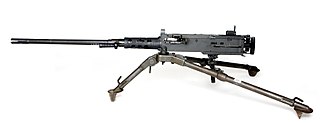
The M2 machine gun or Browning .50 caliber machine gun is a heavy machine gun that was designed near the end of World War I by John Browning. While similar to Browning's M1919 Browning machine gun, which was chambered for the .30-06 cartridge, the M2 uses Browning's larger and more powerful .50 BMG cartridge. The design has had many designations; the official U.S. military designation for the infantry type is Browning Machine Gun, Cal. .50, M2, HB, Flexible. It has been used against infantry, light armored vehicles, watercraft, light fortifications, and low-flying aircraft.

A grenade launcher is a weapon that fires a specially designed, large-caliber projectile, often with an explosive, smoke, or gas warhead. Today, the term generally refers to a class of dedicated firearms firing unitary grenade cartridges. The most common type are man-portable, shoulder-fired weapons issued to individuals, although larger crew-served launchers are issued at higher levels of organization by military forces.

The Objective Individual Combat Weapon or OICW was the next-generation service rifle competition that was under development as part of the United States Army OICW program; the program was eventually discontinued without bringing the weapon out of the prototype phase. The acronym OICW is often used to refer to the entire weapons program.

The Mk 19 grenade launcher is an American 40 mm belt-fed automatic grenade launcher that was first developed during the Vietnam War.

The Barrett XM109, originally known as the Objective Sniper Weapon (OSW) and now called the Anti-Materiel Payload Rifle (AMPR), is a prototype anti-materiel sniper rifle. It is chambered for 25 × 59 mm grenade rounds and was developed by Barrett Firearms Manufacturing. It was designed in accordance with a requirement set out in 1994, and is capable of defeating light armor and equipment out to 2 km (1.2 mi).

The 30 mm caliber is a range of autocannon ammunition. It includes the NATO standardized Swiss 30×173mm, the Soviet 30×155mmB, 30×165mm and 30×210mmB, the Czechoslovak 30×210mm, the Yugoslav 30×192mm, the British 30×113mmB, and the French 30×150mmB and 30×170mm cartridges.

The AGS-17Plamya is a Soviet-designed automatic grenade launcher in service worldwide.
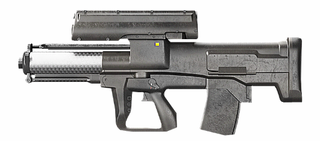
The XM25 Counter Defilade Target Engagement (CDTE) System, also known as the Punisher and Individual Semiautomatic Air Burst System was an airburst grenade launcher with programmable ammunition derived from the XM29 OICW. It was fielded to soldiers serving in the War in Afghanistan in 2010, after which malfunctions and 2013 program budget cuts delayed official entry into service, planned for early 2017. In early 2017, the contract with Orbital ATK was cancelled, calling the future of the entire program into question. The program was officially terminated on 24 July 2018.
The XM312 is a heavy machine gun derived from the XM307 25 mm autocannon and chambered for the .50 BMG cartridge. It was designed in response to a request by the U.S. military for a replacement for the aging M2 Browning heavy machine gun, and as a complement to the heavier XM307 Advanced Crew Served Weapon grenade launcher.
An automatic grenade launcher (AGL) or grenade machine gun is a grenade launcher that is capable of fully automatic fire, and is typically loaded with either an ammunition belt or magazine.
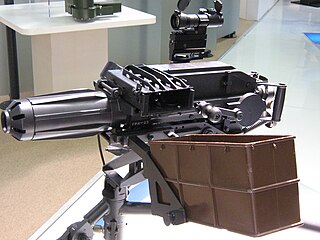
The Denel Y3 AGL is a South African-manufactured automatic grenade launcher currently manufactured by Denel Land Systems. Originally developed by Aram Ltd as the AS88 as a support weapon for infantry, the patent rights were purchased and modified by Vektor, which later became a division of Denel Ltd. Further enhancements included rate of fire upgrade and the addition of a ballistics computer, with final qualification testing taking place in 1998, and operational testing in 2002. The Y3 was launched during the 2003 United Kingdom Defence Systems & Equipment (DSEi) International Exhibition.

The Protector RWS is a remotely controlled weapons station (RWS) that can be mounted to vehicles and stationary platforms. It has been in full scale production since December 2001. It is manufactured by Kongsberg Defence & Aerospace of Norway.

An airburst round is a type of tactical anti-personnel and anti-aircraft explosive ammunition, typically a shell or grenade, that detonates in midair, causing air burst effect fragment damage to enemy personnel or aircraft. In the latter case, airburst rounds are used in anti-aircraft or "zenith" cannon, known in military slang as FLAK or ack-ack.
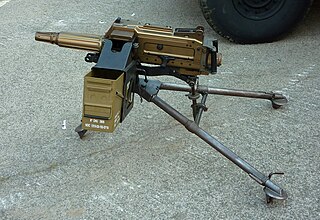
The SB-40 LAG is a 40 mm automatic grenade launcher developed and produced in Spain by the Empresa Nacional Santa Bárbara company.

The XM174 is a mounted automatic 40 mm grenade launcher heavily based on the M1919A4 machine gun and the M79 grenade launcher, but fed from an ammo can. It was used in the Vietnam War as a tripod mounted crew-served weapon and as a weapon mounted on various vehicles and aircraft. The XM174 has the same fire control group as the M1919A4.
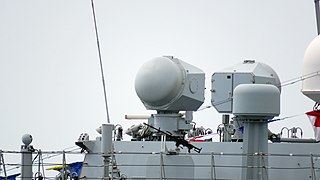
The QJZ-89, also known as the Type 89 heavy machine gun, is a heavy machine gun designed in the People's Republic of China which fires the Soviet 12.7×108mm ammunition.
















